Assessing the Efficiency of Antimicrobial Plant Extracts from Artemisia afra and Eucalyptus globulus as Coatings for Textiles
Abstract
1. Introduction
1.1. Artemisia afra
1.2. Eucalyptus globulus
2. Materials and Methods
2.1. Materials
2.2. Equipment
2.3. Plant Material
2.3.1. Sources of Plant Material and Fabric
2.3.2. Plant Sample Preparation
2.3.3. Plant Extraction
2.3.4. Preparation of Antimicrobial Cotton and Polyester Material
2.4. Experimental Method and Procedure
2.5. Characterizations
2.5.1. Determination of Minimum Inhibitory Concentration
2.5.2. Determination of the Inhibition Zone
- Step 1: Preparation of liquid cultures
| Staphylococcus aureus ATCC 33591 | Nutrient broth |
| Escherichia coli ATCC 25922 | Tryptic soy broth |
- Step 2: Preparation of agar plates
2.6. Durability Tests
2.7. Phytochemical Screening of Artemisia afra and Eucalyptus globulus
2.7.1. Detection of Phenols
2.7.2. Detection of Flavonoids
2.7.3. Detection of Quinones
2.7.4. Detection of Tannins
2.7.5. Test for Saponins
2.7.6. Test for Steroids
2.7.7. Test for Terpenoids
3. Results and Discussion
3.1. Extraction Yield
3.2. Phytochemical Screening Analysis
3.3. Antibacterial Activity of Plant Extracts
3.4. Minimum Inhibition Concentration Analysis
3.5. Zone of Inhibition Analysis
3.6. SEM Analysis
3.7. Durability to Washing
4. Conclusions
Author Contributions
Funding
Data Availability Statement
Acknowledgments
Conflicts of Interest
Abbreviations
| ISO | International Standards Organization |
| PUAEs | Pulsed Ultrasonic Assisted Extractions |
| PPE | Personal Protective Equipment |
| MIC | Minimum inhibitory concentration |
| DMSO | Dimethyl sulfoxide |
| ZOI | Zone of inhibition |
| UV | Ultraviolet |
| COVID-19 | Coronavirus Disease of 2019 |
| w/v | Weight-to-volume ratio |
| FTIR | Fourier-transform infrared spectroscopy |
| MTT | (3-(4,5-Dimethylthiazol-2-yl)-2,5-Diphenyltetrazolium Bromide) |
| E. coli | Escherichia coli |
| S. aureus | Staphylococcus aureus |
| S. pyogenes | Streptococcus pyogenes |
| H. influenzae | Hemophilus influenzae |
| AATCC | American Association of Textile Chemists and Colorists |
| PPL | Priority Pathogen List |
| WHO | World Health Organization |
References
- Chauhan, P.; Kumar, A. Development of a Microbial Coating for Cellulosic Surface Using Aloe Vera and Silane. Carbohydr. Polym. Technol. Appl. 2020, 1, 100015. [Google Scholar] [CrossRef]
- Ibrahim, W.; Sarwar, Z.; Abid, S.; Munir, U.; Azeem, A. Aloe Vera Leaf Gel Extract for Antibacterial and Softness Properties of Cotton. J. Text. Sci. Eng. 2017, 7, 1–6. [Google Scholar] [CrossRef]
- Massella, D.; Argenziano, M.; Ferri, A.; Guan, J.; Giraud, S.; Cavalli, R.; Barresi, A.A.; Salaün, F. Salaün Bio-Functional Textiles: Combining Pharmaceutical Nanocarriers with Fibrous Materials for Innovative Dermatological Therapies. Pharmaceutics 2019, 11, 403. [Google Scholar] [CrossRef]
- Fortune Business Insights. Antimicrobial Textiles Market Size, Share and COVID19, Impact Analysis, by Active Agents (Synthetic Organic Compounds, Bio-Based Compounds, Metal and Metallic Salts and Others) by Fabric (Cotton, Polyester and Others) by Application (Home, Commercial, Medical, Apparel, Industrial and Others and Regional Forecasts, 2021–2028); Fortune Business Insights: Maharashtra, India, 2021. [Google Scholar]
- Suriati, L.; Utama, I.M.S. Characteristic Fillet of Aloe Vera Gel as Edible Coating. J. Phys. Conf. Ser. 2019, 1402, 066021. [Google Scholar] [CrossRef]
- Bouchekrit, M.; Laouer, H.; Hajji, M.; Nasri, M.; Haroutounian, S.A.; Akkal, S. Essential Oils from Elaeoselinum Asclepium: Chemical Composition, Antimicrobial and Antioxidant Properties. Asian. Pac. J. Trop. Biomed. 2016, 6, 851–857. [Google Scholar] [CrossRef]
- Yimam, B.B.; Desalew, A. Phytochemical Screening, Antibacterial Effect, and Essential Oil Extract from the Leaf of Artemisia Afra against on Selected Pathogens. Adv. Microbiol. 2022, 12, 386–397. [Google Scholar] [CrossRef]
- Shala, A.Y.; Gururani, M.A. Phytochemical Properties and Diverse Beneficial Roles of Eucalyptus globulus Labill.: A Review. Horticulturae 2021, 7, 450. [Google Scholar] [CrossRef]
- Patil, G.; Dass, S.; Chandra, R. Artemisia Afra and Modern Diseases. J. Pharmacogenomics Pharmacoproteomics 2011, 2, 603–608. [Google Scholar] [CrossRef]
- Muyima, N.Y.O.; Zulu, G.; Bhengu, T.; Popplewell, D. The Potential Application of Some Novel Essential Oils as Natural Cosmetic Preservatives in an Aqueous Cream Formulation. Flavour. Fragr. J. 2002, 17, 258–266. [Google Scholar] [CrossRef]
- Martini, M.C.; Zhang, T.; Williams, J.T.; Abramovitch, R.B.; Weathers, P.J.; Shell, S.S. Artemisia Annua and Artemisia Afra Extracts Exhibit Strong Bactericidal Activity against Mycobacterium Tuberculosis. J. Ethnopharmacol. 2020, 262, 113191. [Google Scholar] [CrossRef] [PubMed]
- Abad, M.J.; Bedoya, L.M.; Apaza, L.; Bermejo, P. The Artemisia L. Genus: A Review of Bioactive Essential Oils. Molecules 2012, 17, 2542–2566. [Google Scholar] [CrossRef]
- Bajaj, Y.P.S. Biotechnology in Agriculture and Forestry. In Somatic Embryogenesis and Synthetic Seed I; Bajaj, Y.P.S., Ed.; Springer: Berlin/Heidelberg, Germany, 1995; Volume 30, ISBN 978-3-642-08183-5. [Google Scholar]
- González-Burgos, E.; Liaudanskas, M.; Viškelis, J.; Žvikas, V.; Janulis, V.; Gómez-Serranillos, M.P. Antioxidant Activity, Neuroprotective Properties and Bioactive Constituents Analysis of Varying Polarity Extracts from Eucalyptus globulus Leaves. J. Food Drug. Anal. 2018, 26, 1293–1302. [Google Scholar] [CrossRef]
- Silva, J.; Abebe, W.; Sousa, S.M.; Duarte, V.G.; Machado, M.I.L.; Matos, F.J.A. Analgesic and Anti-Inflammatory Effects of Essential Oils of Eucalyptus. J. Ethnopharmacol. 2003, 89, 277–283. [Google Scholar] [CrossRef] [PubMed]
- Barker, S.C.; Altman, P.M. An Ex Vivo, Assessor Blind, Randomised, Parallel Group, Comparative Efficacy Trial of the Ovicidal Activity of Three Pediculicides after a Single Application—Melaleuca Oil and Lavender Oil, Eucalyptus Oil and Lemon Tea Tree Oil, and a “Suffocation” Pediculicide. BMC Dermatol 2011, 11, 14. [Google Scholar] [CrossRef]
- Chandra, H.; Bishnoi, P.; Yadav, A.; Patni, B.; Mishra, A.P.; Nautiyal, A.R. Antimicrobial Resistance and the Alternative Resources with Special Emphasis on Plant-Based Antimicrobials—A Review. Plants 2017, 6, 457–462. [Google Scholar] [CrossRef] [PubMed]
- Kutama, R. Phytochemical Compositions in Some Nigerian Medicinal Plants and Their Pharmacological Properties: A Review. J. Anesthesiol. 2018, 6, 15–25. [Google Scholar] [CrossRef]
- Restuati, M.; Diningrat, D.S. Antimicrobial Profile of Premna Pubescens. Blume and Centella Asiatica Extracts Against Bacteria and Fungi Pathogens. Int. J. Pharmacol. 2018, 14, 271–275. [Google Scholar] [CrossRef]
- Smeriglio, A.; Denaro, M.; Barreca, D.; Calderaro, A.; Bisignano, C.; Ginestra, G.; Bellocco, E.; Trombetta, D. In Vitro Evaluation of the Antioxidant, Cytoprotective, and Antimicrobial Properties of Essential Oil from Pistacia vera L. Variety Bronte Hull. 2017, 18, 1212. [Google Scholar] [CrossRef]
- Baydoun, S.; Chalak, L.; Dalleh, H.; Arnold, N. Ethnopharmacological Survey of Medicinal Plants Used in Traditional Medicine by the Communities of Mount Hermon, Lebanon. J. Ethnopharmacol. 2015, 173, 139–156. [Google Scholar] [CrossRef]
- Singh, A.; Nautiyal, M.C.; Kunwar, R.M.; Bussmann, R.W. Ethnomedicinal Plants Used by Local Inhabitants of Jakholi Block, Rudraprayag District, Western Himalaya, India. J. Ethnobiol. Ethnomed. 2017, 13, 1–29. [Google Scholar] [CrossRef]
- Oyedeji, A.; Afolayan, A.; Hutchings, A. Compositional Variation of the Essential Oils of Artemisia Afra Jacq. from Three Provinces in South Africa—A Case Study of Its Safety. Nat. Prod. Commun. 2009, 4, 849–852. [Google Scholar] [CrossRef]
- Rotzler, S.; von Krshiwoblozki, M.; Schneider-Ramelow, M. Washability of e-textiles: Current testing practices and the need for standardization. Text. Res. J. 2021, 91, 2401–2417. [Google Scholar] [CrossRef]
- Marković, D.; Milovanović, S.; De Clerck, K.; Zizovic, I.; Stojanović, D.; Radetić, M. Development of Material with Strong Antimicrobial Activity by High Pressure CO2 Impregnation of Polyamide Nanofibers with Thymol. J. CO2 Util. 2018, 26, 19–27. [Google Scholar] [CrossRef]
- Odutayo, F.; Ezeamagu, C.; Kabiawu, T.; Aina, D.; Mensah-Agyei, G. Phytochemical Screening and Antimicrobial Activity of Chromolaena Odorata Leaf Extract against Selected Microorganisms. J. Adv. Med. Pharm. Sci. 2017, 13, 1–9. [Google Scholar] [CrossRef] [PubMed]
- Kane, N.F.; Kyama, M.C.; Nganga, J.K.; Hassanali, A.; Diallo, M.; Kimani, F.T. Comparison of Phytochemical Profiles and Antimalarial Activities of Artemisia Afra Plant Collected from Five Countries in Africa. S. Afr. J. Bot. 2019, 125, 126–133. [Google Scholar] [CrossRef]
- Othman, L.; Sleiman, A.; Abdel-Massih, R.M. Antimicrobial Activity of Polyphenols and Alkaloids in Middle Eastern Plants. Front. Microbiol. 2019, 10, 911. [Google Scholar] [CrossRef]
- Ameer, K.; Shahbaz, H.M.; Kwon, J.-H. Green Extraction Methods for Polyphenols from Plant Matrices and Their Byproducts: A Review. Compr. Rev. Food Sci. Food Saf. 2017, 16, 295–315. [Google Scholar] [CrossRef] [PubMed]
- Ndezo Bisso, B.; Njikang Epie Nkwelle, R.; Tchuenguem Tchuenteu, R.; Dzoyem, J.P. Phytochemical Screening, Antioxidant, and Antimicrobial Activities of Seven Underinvestigated Medicinal Plants against Microbial Pathogens. Adv. Pharmacol. Pharm. Sci. 2022, 2022, 1998808. [Google Scholar] [CrossRef]
- Alaribe, F.N.; Maepa, M.J.; Mkhumbeni, N.; Motaung, S.C. Possible Roles of Eucomis Autumnalis in Bone and Cartilage Regeneration: A Review. Trop. J. Pharm. Res. 2018, 17, 741. [Google Scholar] [CrossRef]
- Sumantri, I.B.; Wahyuni, H.S.; Mustanti, L.F. Total Phenolic, Total Flavonoid and Phytochemical Screening by FTIR Spectroscopic of Standardized Extract of Mikania Micrantha Leaf. Pharmacogn. J. 2020, 12, 1395–1401. [Google Scholar] [CrossRef]
- Hayat, J.; Akodad, M.; Moumen, A.; Baghour, M.; Skalli, A.; Ezrari, S.; Belmalha, S. Phytochemical Screening, Polyphenols, Flavonoids and Tannin Content, Antioxidant Activities and FTIR Characterization of Marrubium vulgare L. from Two Different Localities of Northeast of Morocco. Heliyon 2020, 6, e05609. [Google Scholar] [CrossRef] [PubMed]
- Nandiyanto, A.B.D.; Oktiani, R.; Ragadhita, R. How to Read and Interpret FTIR Spectroscope of Organic Material. Indones. J. Sci. Technol. 2019, 4, 97. [Google Scholar] [CrossRef]
- Arockia, J.P.; Gowri, V.; Dharmalingam, R.; Shobanaa, A. Prema Phytochemical Screening by FTIR Spectroscopic Analysis of Leaf and Stem Extracts of Wedelia Biflora. Int. J. Nano Corros. Sci. Eng. 2015, 2, 322–334. [Google Scholar]
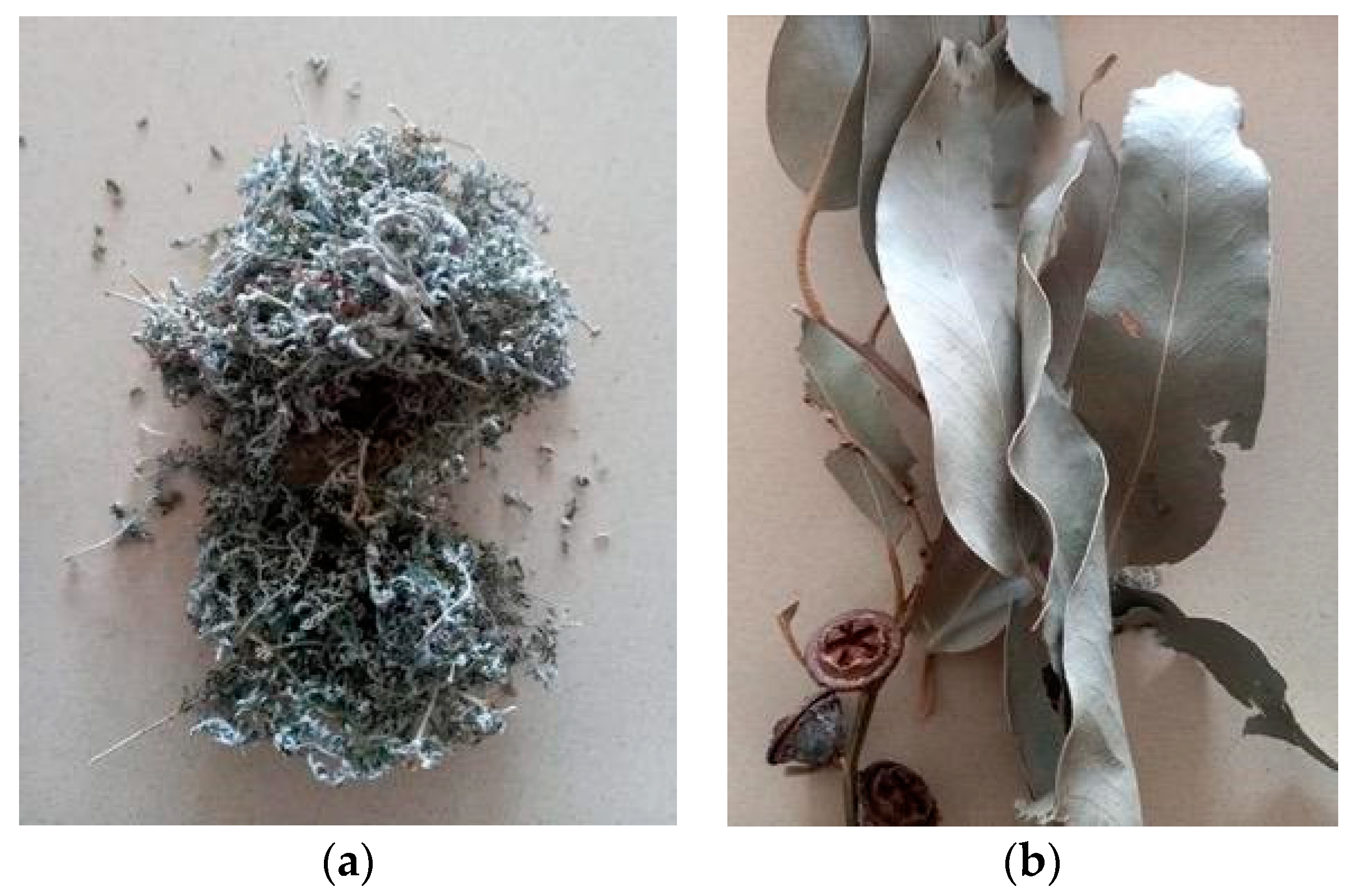
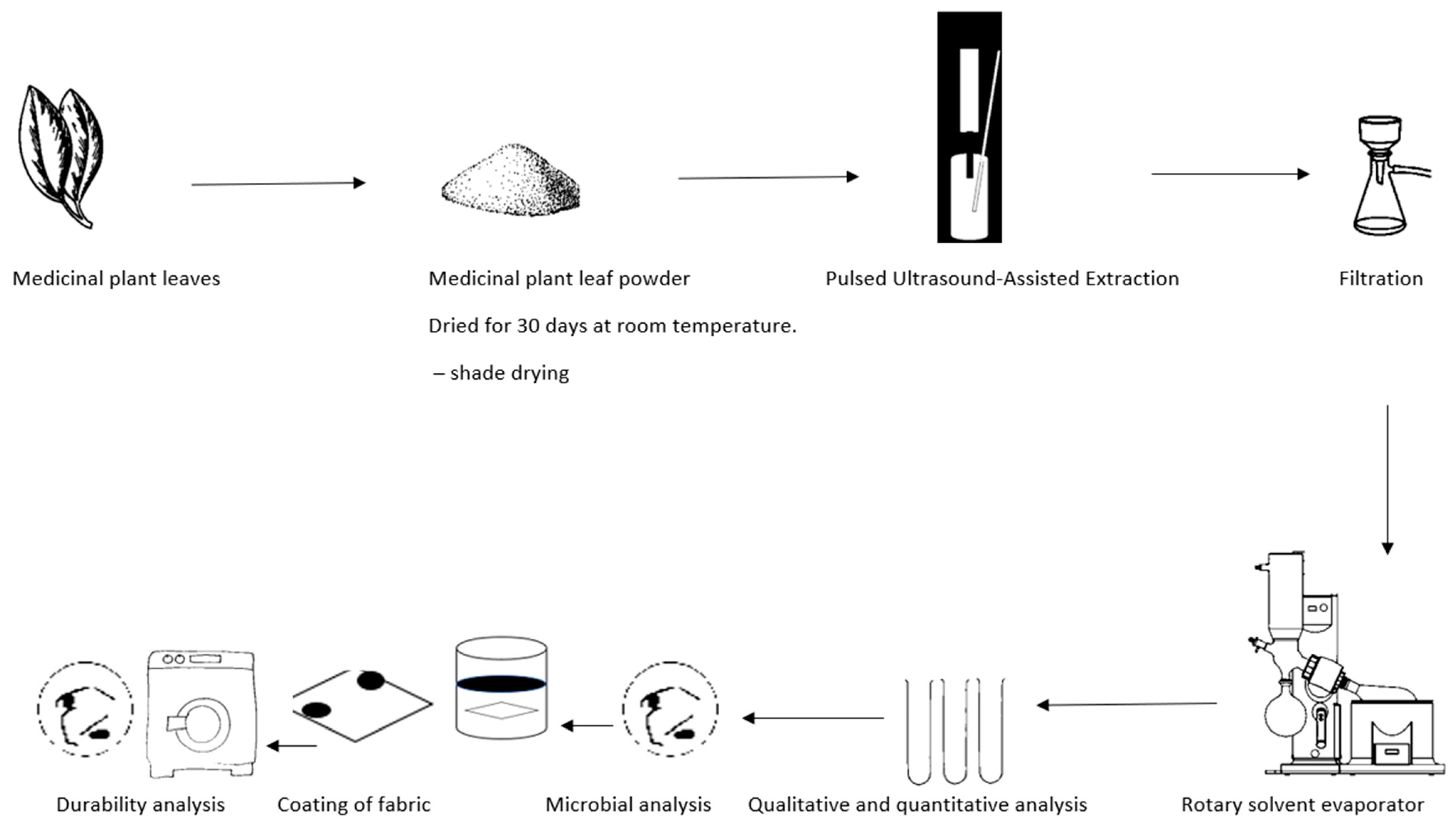
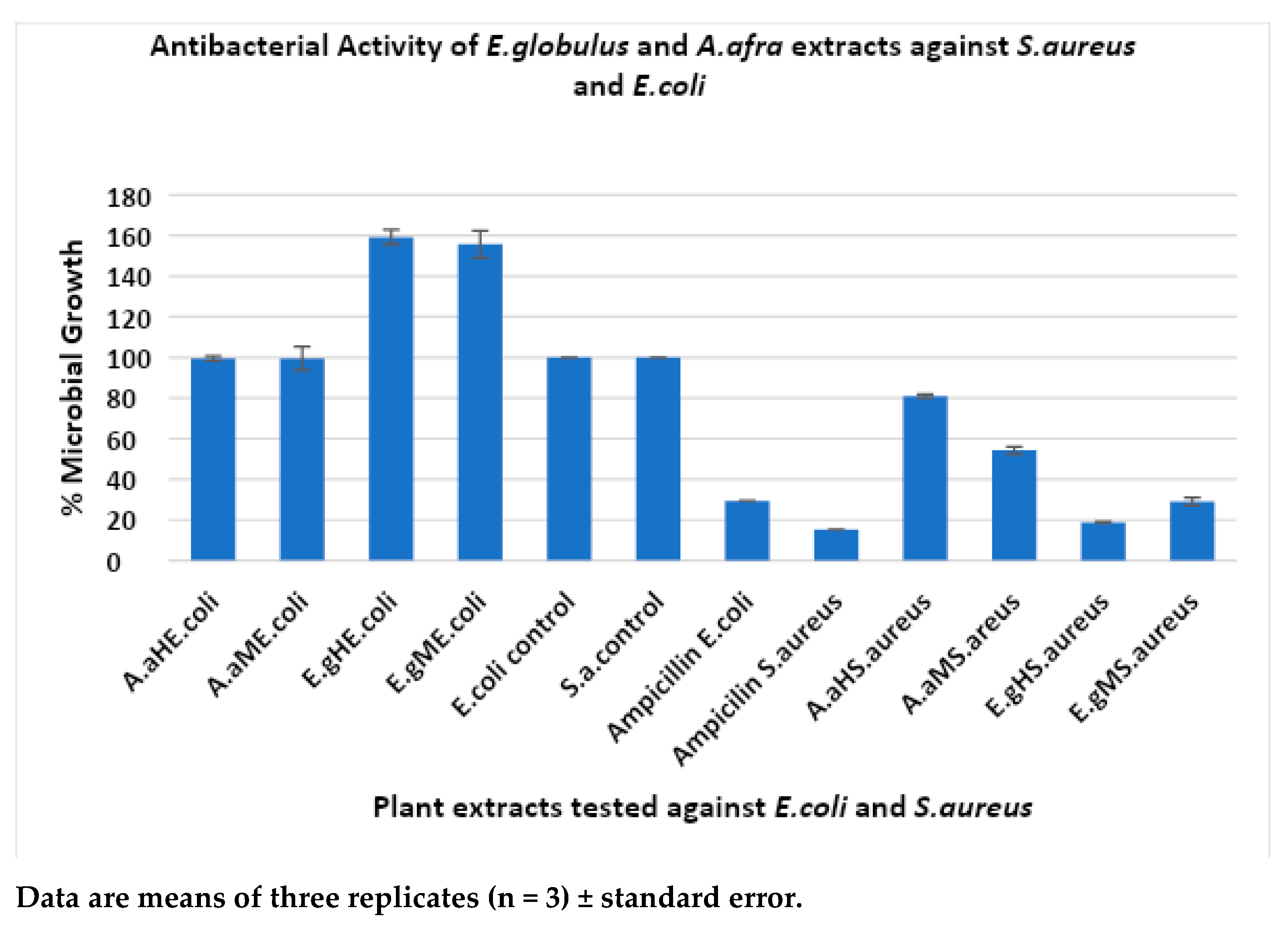
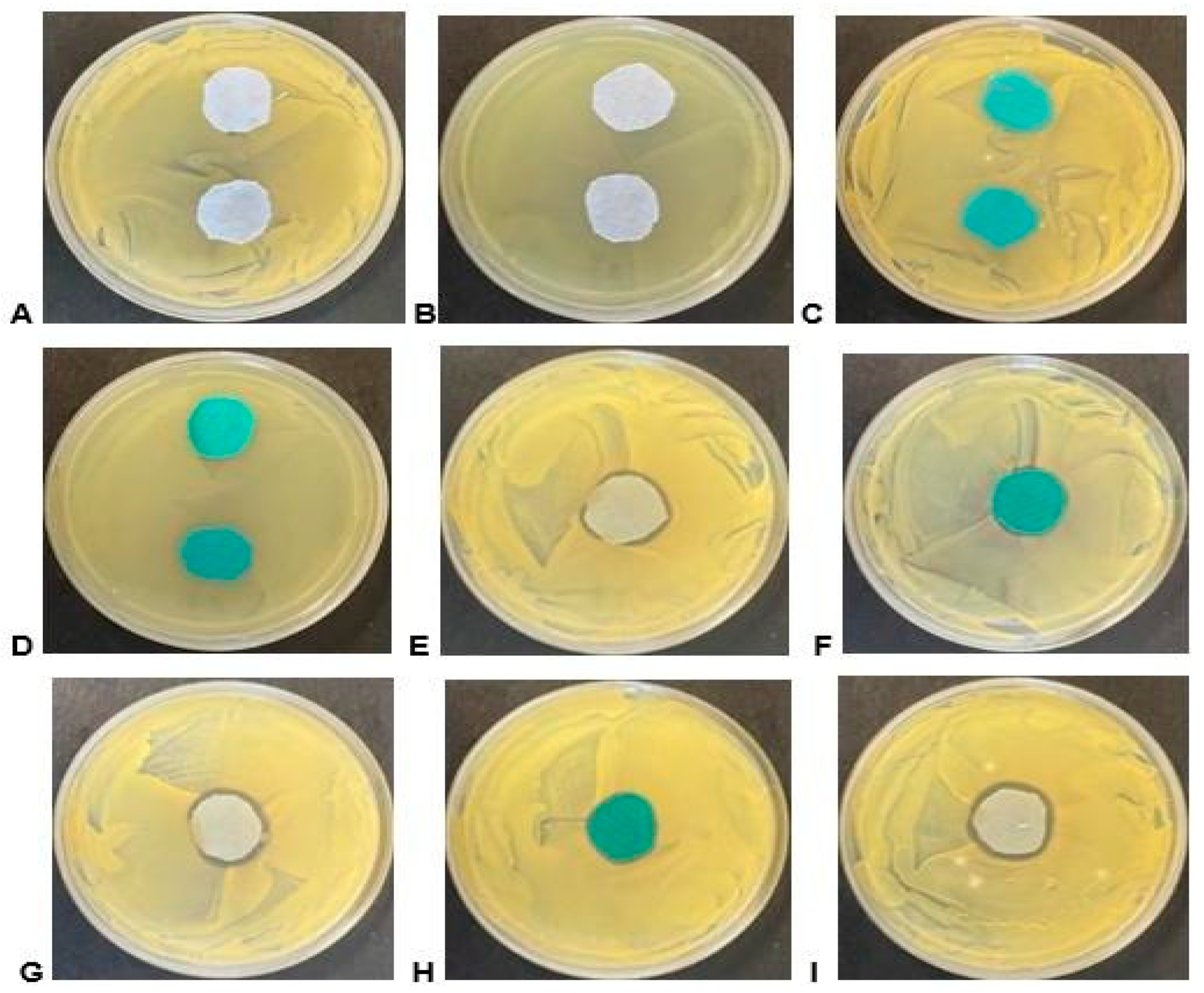

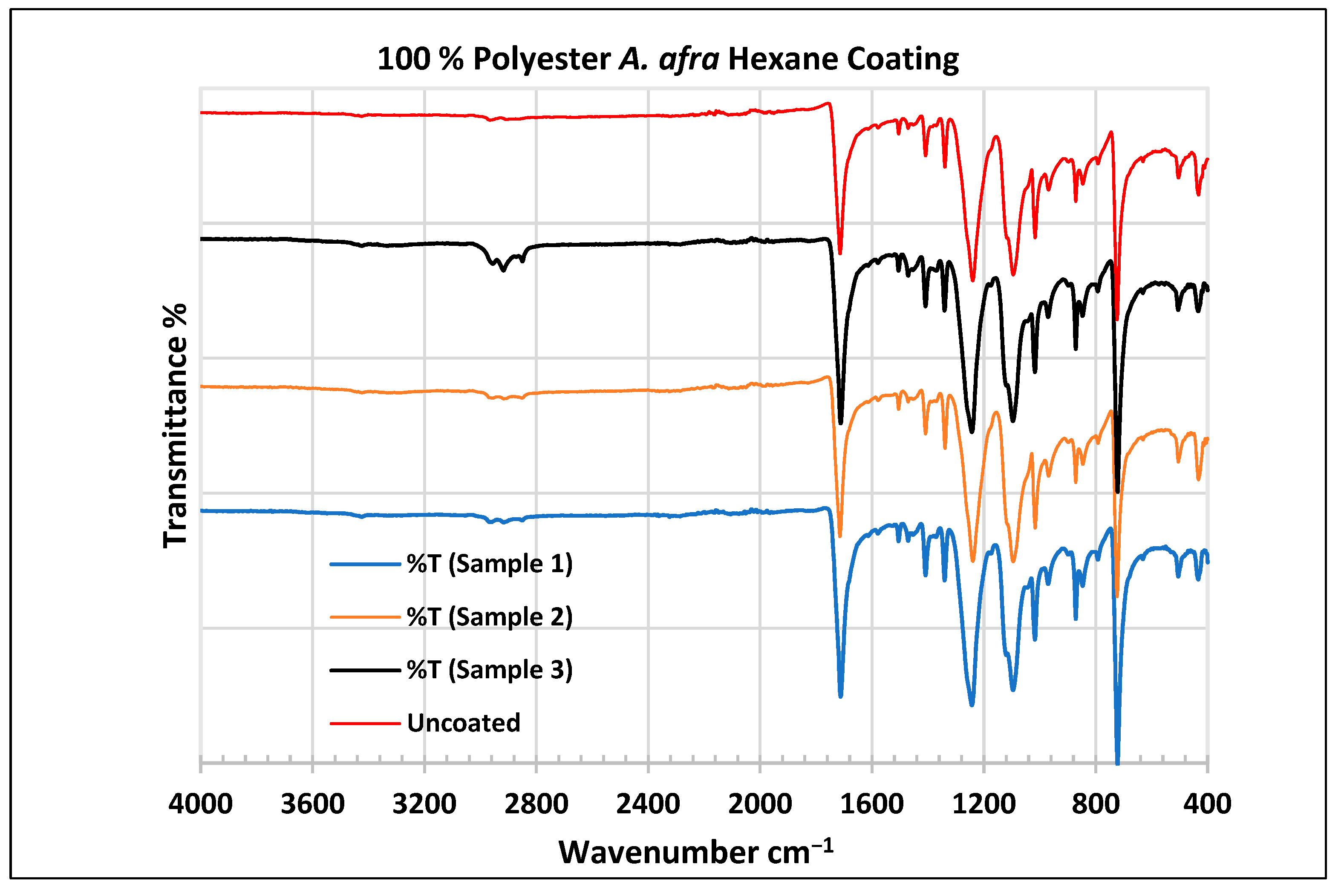
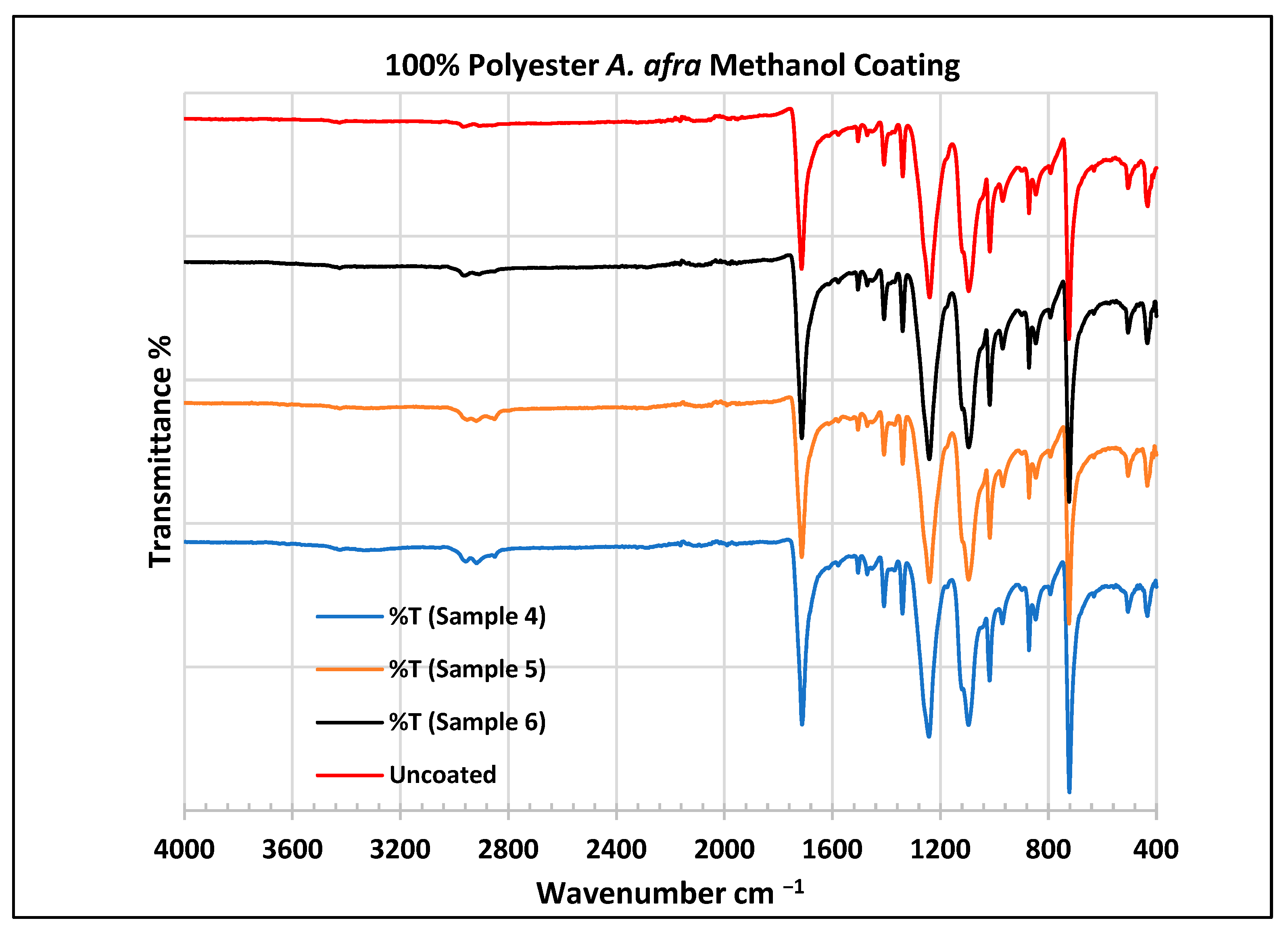

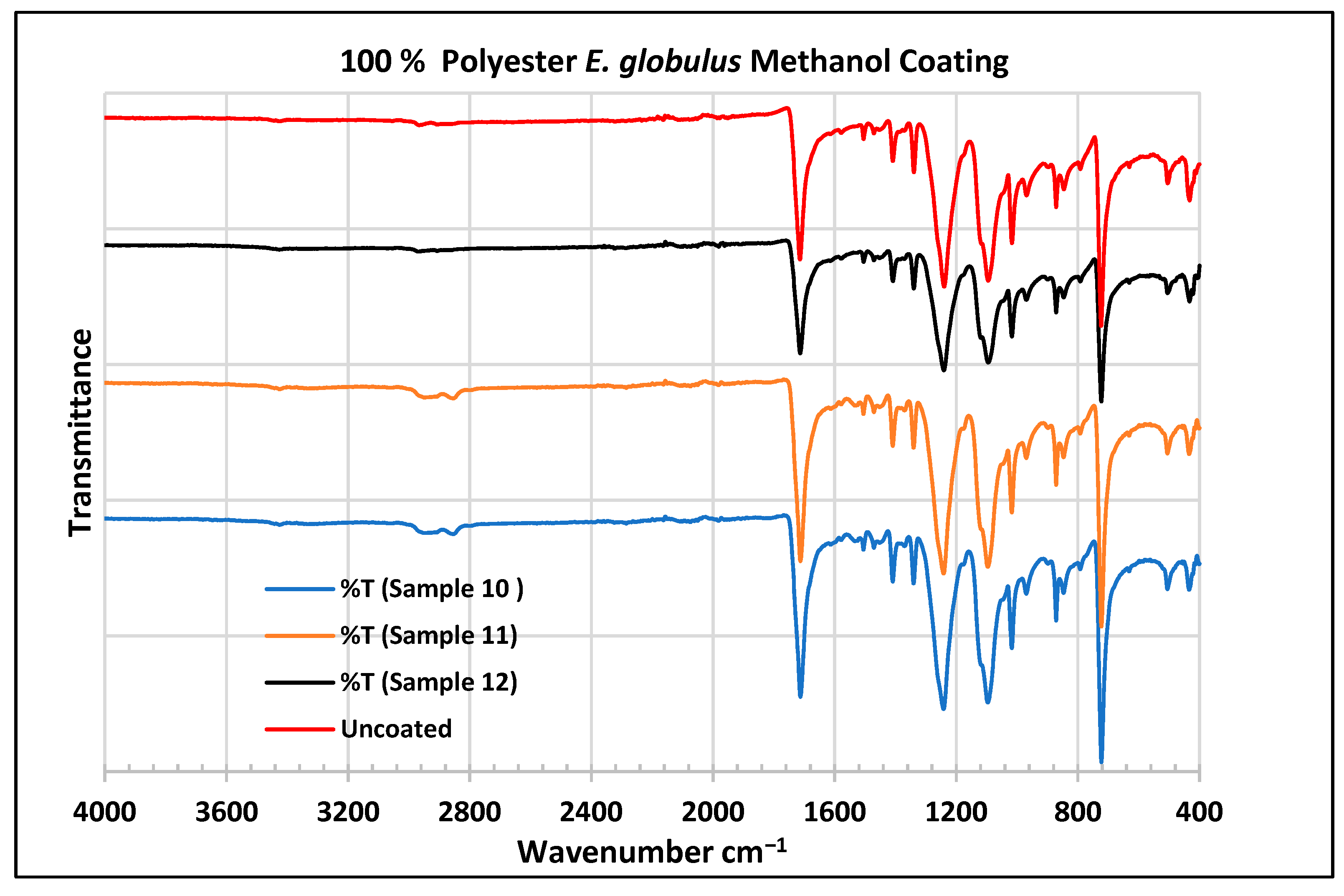
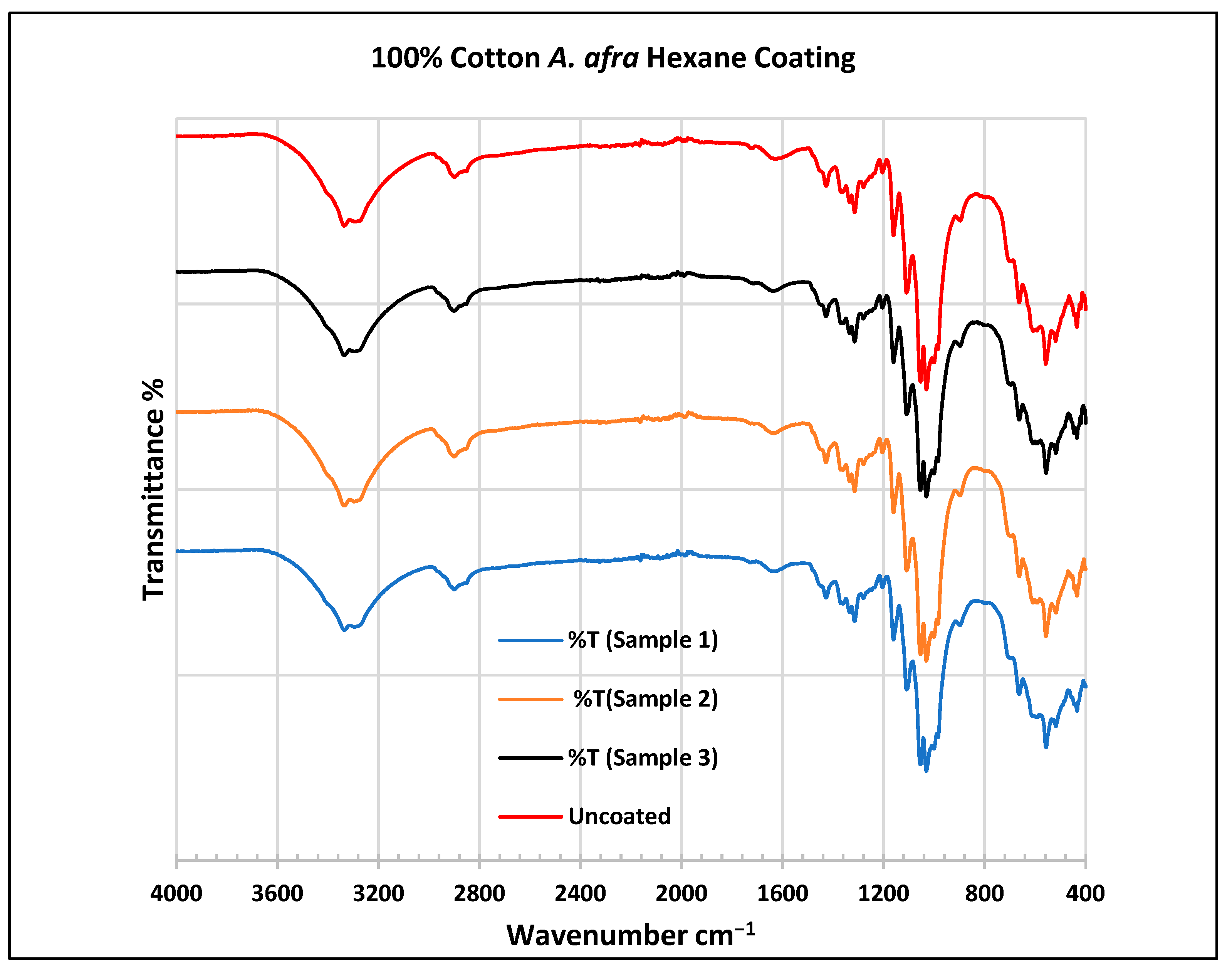


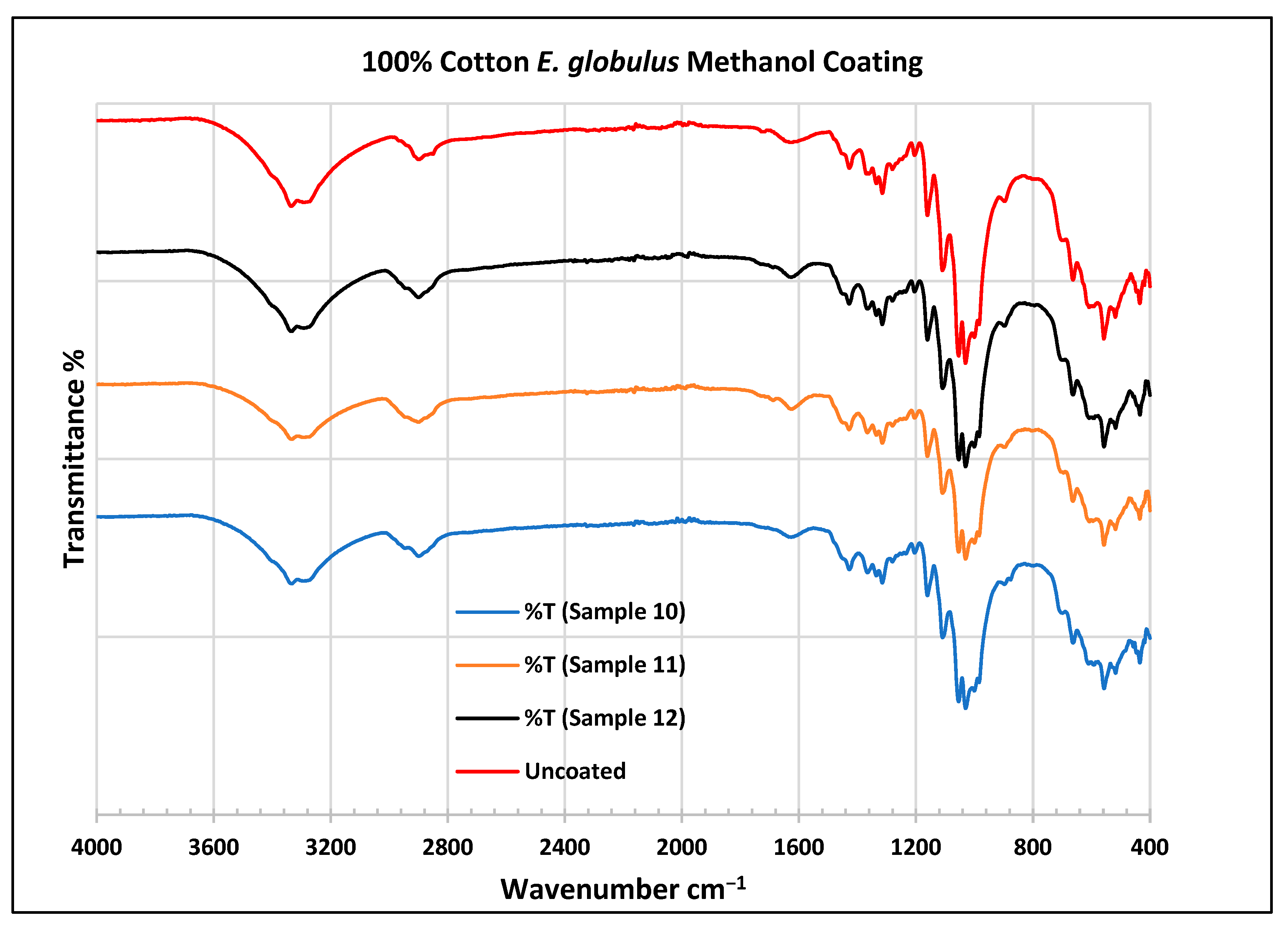
| No. | Parameter | PUAE Extraction |
|---|---|---|
| 1 | Sample size (g) | 10 g |
| 2 | Extraction solvent | n-hexane and methanol |
| 3 | Solvent volume (mL) | 100 mL |
| 4 | Temperature (°C) | 40 °C |
| 5 | Time (min) | 20 min |
| A. afra Hexane Extract (g) | A. afra Methanol Extract (g) | E. globulus Hexane Extract (g) | E. globulus Methanol Extract (g) | |
|---|---|---|---|---|
| 0.259 | 0.979 | 0.390 | 2.233 | |
| 0.198 | 0.899 | 0.403 | 2.234 | |
| 0.202 | 0.888 | 0.400 | 2.362 | |
| Avg. Yield % | 2.192 | 9.221 | 3.979 | 22.762 |
| SD% | 0.280 | 0.403 | 0.055 | 0.607 |
| Plant | Artemisia afra | Eucalyptus globulus | ||
|---|---|---|---|---|
| Solvent | Methanol | n-Hexane | Methanol | n-Hexane |
| Phytochemicals | ||||
| Phenol | + | + | + | + |
| Flavonoids | + | + | − | + |
| Quinones | + | + | + | + |
| Tannins | + | − | + | − |
| Saponins | + | − | + | − |
| Terpenoids | + | − | + | + |
| Steroids | + | + | + | + |
| Sample No. Plant Extract | MIC Values (µg/mL) | |
|---|---|---|
| Microorganisms | ||
| Gram-Negative Bacteria E. coli ATCC 25922 (Tryptic Soy Broth) | Gram-Positive Bacteria S. aureus subsp. Aureus ATCC 33,591 (Nutrient Broth) | |
| 1 A. aH | 50–500 μg/mL | 5–25 μg/mL; 250–500 μg/mL |
| 2 A. aH | 10–500 μg/mL | 125–500 μg/mL |
| 3 A. aH | None | 50–500 μg/mL |
| 4 A. aM | 5–500 μg/mL | 5–500 μg/mL |
| 5 A. aM | 5–500 μg/mL | 5 μg/mL; 125–500 μg/mL |
| 6 A. aM | 10–500 μg/mL | 100–500 μg/mL |
| 7 E. gH | 5–50 μg/mL * | None |
| 8 E. gH | 250–500 μg/mL | None |
| 9 E. gH | 100–500 μg/mL | None |
| 10 E. gM | None | None |
| 11 E. gM | None | 250–500 μg/mL |
| 12 E. gM | None | None |
| Sample No. Plant Extract | Material Type | Disk Diameter | Zone Diameter | Zone of Inhibition |
|---|---|---|---|---|
| 10 E. gMC | Light blue/grey cotton | 20 mm | 23 mm | 101.32 mm2 |
| 10 E. gMP | Turquoise polyester | 20 mm | 22 mm | 65.97 mm2 |
| 11 E. gMC | Light blue/grey cotton | 20 mm | 27 mm | 258.40 mm2 |
| 11 E. gMP | Turquoise polyester | 19 mm | 22 mm | 96.60 mm2 |
| 12 E. gMC | Light blue/grey cotton | 20 mm | 25 mm | 176.71 mm2 |
Disclaimer/Publisher’s Note: The statements, opinions and data contained in all publications are solely those of the individual author(s) and contributor(s) and not of MDPI and/or the editor(s). MDPI and/or the editor(s) disclaim responsibility for any injury to people or property resulting from any ideas, methods, instructions or products referred to in the content. |
© 2024 by the authors. Licensee MDPI, Basel, Switzerland. This article is an open access article distributed under the terms and conditions of the Creative Commons Attribution (CC BY) license (https://creativecommons.org/licenses/by/4.0/).
Share and Cite
Nortjie, E.; Basitere, M.; Moyo, D.; Nyamukamba, P. Assessing the Efficiency of Antimicrobial Plant Extracts from Artemisia afra and Eucalyptus globulus as Coatings for Textiles. Plants 2024, 13, 514. https://doi.org/10.3390/plants13040514
Nortjie E, Basitere M, Moyo D, Nyamukamba P. Assessing the Efficiency of Antimicrobial Plant Extracts from Artemisia afra and Eucalyptus globulus as Coatings for Textiles. Plants. 2024; 13(4):514. https://doi.org/10.3390/plants13040514
Chicago/Turabian StyleNortjie, Elvino, Moses Basitere, Doice Moyo, and Pardon Nyamukamba. 2024. "Assessing the Efficiency of Antimicrobial Plant Extracts from Artemisia afra and Eucalyptus globulus as Coatings for Textiles" Plants 13, no. 4: 514. https://doi.org/10.3390/plants13040514
APA StyleNortjie, E., Basitere, M., Moyo, D., & Nyamukamba, P. (2024). Assessing the Efficiency of Antimicrobial Plant Extracts from Artemisia afra and Eucalyptus globulus as Coatings for Textiles. Plants, 13(4), 514. https://doi.org/10.3390/plants13040514








